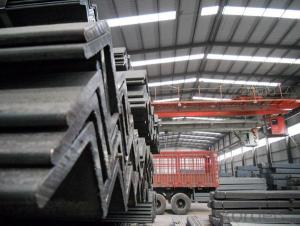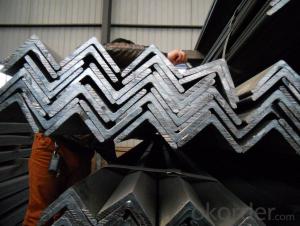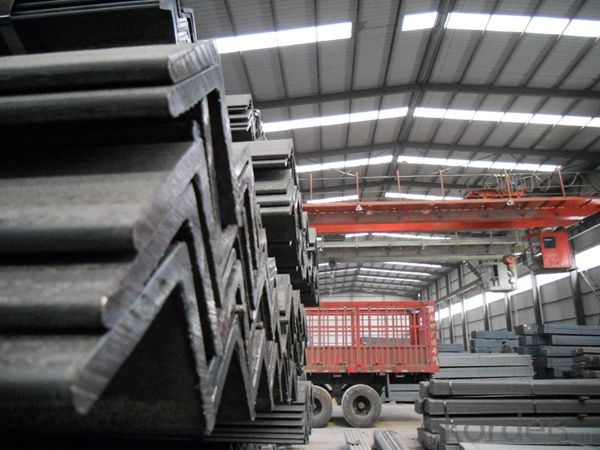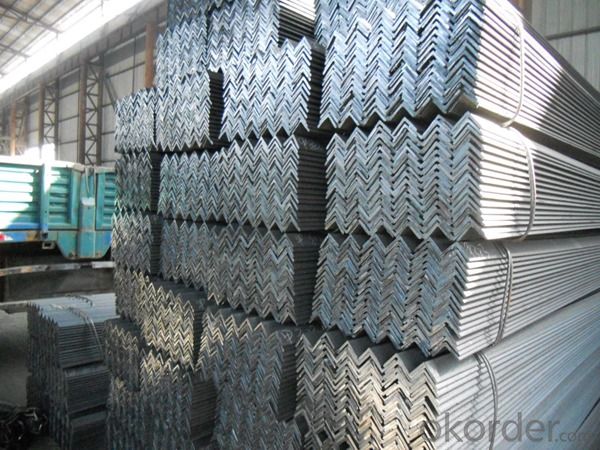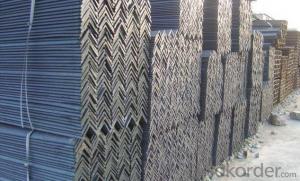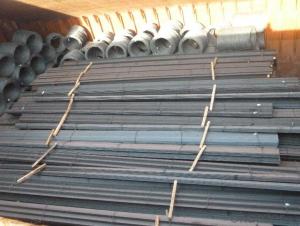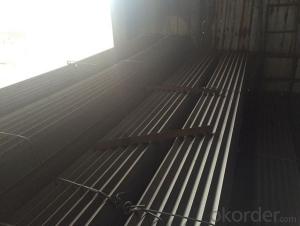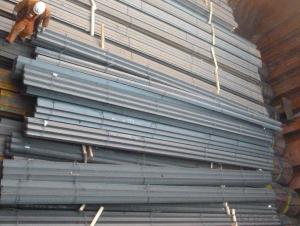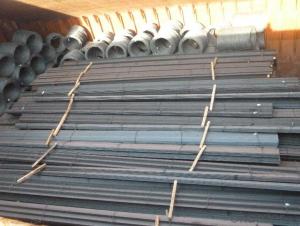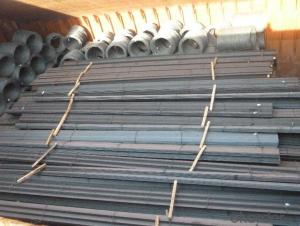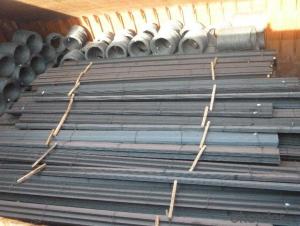Hot Rolled EN Standard Equal Angle Steel Bars for Construction, Structure
- Loading Port:
- Tianjin
- Payment Terms:
- TT OR LC
- Min Order Qty:
- 25 m.t.
- Supply Capability:
- 200000 m.t./month
OKorder Service Pledge
OKorder Financial Service
You Might Also Like
Product Description:
OKorder is offering Hot Rolled EN Standard Equal Angle Steel Bars for Construction, Structure at great prices with worldwide shipping. Our supplier is a world-class manufacturer of steel, with our products utilized the world over. OKorder annually supplies products to European, North American and Asian markets. We provide quotations within 24 hours of receiving an inquiry and guarantee competitive prices.
Product Applications:
Hot Rolled EN Standard Equal Angle Steel Bars for Construction, Structure are ideal for structural applications and are widely used in the construction of buildings and bridges, and the manufacturing, petrochemical, and transportation industries.
1. Supporting members, most commonly in the house raising industry to strengthen timber bears under houses. Transmission line towers, etc
2. Prefabricated structure
3. Medium scale bridges
4. It is widely used in various building structures and engineering structures such as roof beams, bridges, transmission towers, hoisting machinery and transport machinery, ships, industrial furnaces, reaction tower, container frame and warehouse etc.
Product Advantages:
Hot Rolled EN Standard Equal Angle Steel Bars for Construction, Structure are durable, strong, and resist corrosion.
Main Product Features:
· Premium quality
· Prompt delivery & seaworthy packing (30 days after receiving deposit)
· Corrosion resistance
· Can be recycled and reused
· Mill test certification
· Professional Service
· Competitive pricing
Product Specifications:
1.Standards:GB,ASTM,BS,AISI,DIN,JIS
2.Length:6m,9m,12m
3.Material:GBQ235B,Q345BorEquivalent;ASTMA36;EN10025,S235JR,S355JR;JISG3192,SS400;SS540.
4. Sizes
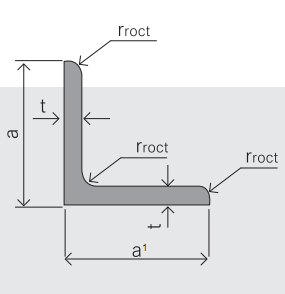
Sizes: 25mm-250mm | ||
a*t | ||
25*2.5-4.0 | 70*6.0-9.0 | 130*9.0-15 |
30*2.5-6.6 | 75*6.0-9.0 | 140*10-14 |
36*3.0-5.0 | 80*5.0-10 | 150*10-20 |
38*2.3-6.0 | 90*7.0-10 | 160*10-16 |
40*3.0-5.0 | 100*6.0-12 | 175*12-15 |
45*4.0-6.0 | 110*8.0-10 | 180*12-18 |
50*4.0-6.0 | 120*6.0-15 | 200*14-25 |
60*4.0-8.0 | 125*8.0-14 | 250*25 |
5. Payment terms:
1).100% irrevocable L/C at sight.
2).30% T/T prepaid and the balance against the copy of B/L.
3).30% T/T prepaid and the balance against L/C
6.Material details:
Alloy No | Grade | Element (%) | |||||
C | Mn | S | P | Si | |||
Q235 | B | 0.12—0.20 | 0.3—0.7 | ≤0.045 | ≤0.045 | ≤0.3 | |
Alloy No | Grade | Yielding strength point( Mpa) | |||||
Thickness (mm) | |||||||
≤16 | >16--40 | >40--60 | >60--100 | ||||
≥ | |||||||
Q235 | B | 235 | 225 | 215 | 205 | ||
Alloy No | Grade | Tensile strength (Mpa) | Elongation after fracture (%) | ||||
Thickness (mm) | |||||||
≤16 | >16--40 | >40--60 | >60--100 | ||||
≥ | |||||||
Q235 | B | 375--500 | 26 | 25 | 24 | 23 | |
FAQ:
Q1: Why buy Materials & Equipment from OKorder.com?
A1: All products offered byOKorder.com are carefully selected from China's most reliable manufacturing enterprises. Through its ISO certifications, OKorder.com adheres to the highest standards and a commitment to supply chain safety and customer satisfaction.
Q2: How do we guarantee the quality of our products?
A2: We have established an advanced quality management system which conducts strict quality tests at every step, from raw materials to the final product. At the same time, we provide extensive follow-up service assurances as required.
Q3: How soon can we receive the product after purchase?
A3: Within three days of placing an order, we will begin production. The specific shipping date is dependent upon international and government factors, but is typically 7 to 10 workdays.
Q4: What makes stainless steel stainless?
A4: Stainless steel must contain at least 10.5 % chromium. It is this element that reacts with the oxygen in the air to form a complex chrome-oxide surface layer that is invisible but strong enough to prevent further oxygen from "staining" (rusting) the surface. Higher levels of chromium and the addition of other alloying elements such as nickel and molybdenum enhance this surface layer and improve the corrosion resistance of the stainless material.
Q5: Can stainless steel rust?
A5: Stainless does not "rust" as you think of regular steel rusting with a red oxide on the surface that flakes off. If you see red rust it is probably due to some iron particles that have contaminated the surface of the stainless steel and it is these iron particles that are rusting. Look at the source of the rusting and see if you can remove it from the surface.


- Q: Can steel angles be used in electrical applications?
- Yes, steel angles can be used in electrical applications. Steel angles are commonly used as structural supports in various industries, including electrical applications. They provide stability and strength to electrical installations, especially when used for mounting electrical equipment such as junction boxes, panels, or conduits. Steel angles are durable and offer excellent load-bearing capacity, making them suitable for supporting heavy electrical components. They are also corrosion-resistant, which is crucial in electrical applications where moisture or environmental factors may be present. Moreover, steel angles can be easily customized and fabricated to meet specific requirements. They can be cut, drilled, welded, or formed into various shapes to accommodate different electrical configurations. This flexibility allows for easy installation and ensures compatibility with other electrical components. In summary, steel angles are a reliable choice for electrical applications due to their strength, durability, corrosion resistance, and versatility. They provide essential support and stability to electrical installations, making them a preferred choice in various electrical projects.
- Q: Are steel angles affected by creep?
- Yes, steel angles can be affected by creep. Creep is the tendency of a material to deform over time under a constant load or stress. While steel is known for its high strength and durability, it is not completely immune to creep. The extent of creep in steel angles will depend on various factors such as the specific type of steel, the temperature, and the applied load. Creep in steel angles can occur at elevated temperatures or when the load is sustained over a long period. When subjected to high temperatures, the atoms within the steel start to move more rapidly, leading to a gradual deformation of the material. This can be a concern in applications where steel angles are exposed to sustained high temperatures, such as in structural components of industrial furnaces or boilers. Additionally, sustained loads can also cause creep in steel angles. Over time, the constant stress on the material can lead to a slow and progressive deformation. This can be particularly significant in situations where the steel angles are subjected to heavy loads for extended periods, such as in long-span bridges or tall buildings. To mitigate the potential effects of creep, engineers and designers must consider the specific requirements of the application and select the appropriate type of steel angle and design parameters. They may also incorporate additional measures such as providing support or reinforcement to minimize the impact of creep on the structural integrity of the steel angles. Regular inspection and maintenance can also help identify any signs of creep and take necessary measures to address them.
- Q: How do you calculate the shear capacity of a steel angle?
- In order to determine the shear capacity of a steel angle, several factors must be taken into account. Firstly, the material properties must be considered. This involves determining the yield strength of the steel angle, which signifies the maximum stress the material can endure before permanent deformation occurs. Next, the cross-sectional area of the steel angle needs to be measured. This can be accomplished by calculating the width and thickness of the angle and multiplying them together. The shear stress applied to the angle can then be calculated by dividing the applied force by the cross-sectional area. To assess the shear capacity, the calculated shear stress is compared to the yield strength of the steel angle. If the shear stress is lower than the yield strength, the angle is deemed safe and capable of withstanding the applied force. Conversely, if the shear stress exceeds the yield strength, the angle may fail and deform. It should be noted that different design codes and standards may have specific equations or factors to be taken into consideration when determining the shear capacity of a steel angle. Therefore, it is advisable to consult the relevant design code or seek assistance from a structural engineer to ensure accurate and secure calculations.
- Q: What are the different methods for cutting steel angles?
- There are several different methods for cutting steel angles, including using a bandsaw, a chop saw, an angle grinder, a plasma cutter, or a laser cutter. The choice of method depends on factors such as the thickness of the steel, accuracy requirements, and the desired finish.
- Q: How are steel angles manufactured?
- Steel angles are typically manufactured through a process called hot rolling, where a steel billet is heated and passed through a series of rollers to give it the desired shape and dimensions. This process ensures that the angles have a consistent and uniform profile, making them suitable for various structural and construction applications.
- Q: What are the environmental benefits of using steel angles?
- Using steel angles in construction and various industries offers numerous environmental advantages. Firstly, steel is a material that is highly recyclable. The production process of steel angles involves recycling scrap steel, which reduces the need for extracting and processing new raw materials. This recycling process helps conserve natural resources and reduces the energy and water consumption associated with mining and refining metals. Furthermore, steel is renowned for its durability and long lifespan. Steel angles have a long-lasting nature and require minimal maintenance, reducing the need for frequent replacements. This durability aids in minimizing waste and the environmental impact linked to manufacturing and disposing of new materials. Moreover, steel is a non-combustible material, making it a safer choice for construction. Unlike certain other materials, steel angles do not contribute to the spread of fires, reducing the risk of environmental damage and potential harm to human health. Additionally, steel is highly energy-efficient. Steel angles can be manufactured using processes that prioritize energy efficiency, and steel structures are known for their thermal efficiency. This means that steel buildings require less energy for heating and cooling, ultimately reducing overall energy consumption and greenhouse gas emissions. Lastly, the use of steel angles can contribute to sustainable building practices. Steel structures can be designed in a manner that maximizes natural light and ventilation, reducing the need for artificial lighting and air conditioning. Furthermore, steel can be easily repurposed or recycled at the end of its lifespan, further reducing waste and environmental impact. In conclusion, the utilization of steel angles yields environmental benefits such as recyclability, durability, non-combustibility, energy efficiency, and the promotion of sustainable building practices. By opting for steel angles in construction and industrial applications, we can effectively minimize resource consumption, waste generation, and greenhouse gas emissions, thereby fostering a more sustainable and environmentally-friendly future.
- Q: Are steel angles available in different colors?
- Steel angles typically come in a standard metallic gray color, but it's possible to alter their color or appearance by applying different finishes or coatings. Options like powder coating, paint, or galvanization can offer a variety of colors to choose from. However, it's worth mentioning that the range of available colors may vary depending on the manufacturer or supplier.
- Q: How do you determine the shear capacity of a steel angle?
- To determine the shear capacity of a steel angle, several factors need to be considered. The shear capacity is the maximum load that the angle can sustain without failure in shear. The first step in determining the shear capacity is to identify the properties of the steel angle, such as the material grade and dimensions. The grade of the steel determines its strength properties, which are crucial for calculating the shear capacity. The dimensions of the angle, including the length, width, and thickness, will also play a significant role in the calculations. Next, it is necessary to determine the critical shear area of the angle. This area represents the portion of the angle that will experience the highest shear stress during loading. The critical shear area can be calculated by considering the location of the applied load and the geometry of the angle. Once the critical shear area is determined, the next step is to calculate the shear stress acting on this area. The shear stress is calculated by dividing the applied load by the area. It is important to ensure that the shear stress does not exceed the allowable shear stress for the specific grade of steel being used. The allowable shear stress is typically provided by design codes or standards. Finally, the shear capacity of the steel angle can be calculated by multiplying the shear stress by the critical shear area. This calculation provides the maximum load that the angle can sustain without failure in shear. It is important to note that the shear capacity of a steel angle may be influenced by other factors such as the presence of holes or welds, which can weaken the structure. In such cases, additional calculations or considerations may be required. Overall, determining the shear capacity of a steel angle involves considering the properties of the steel, calculating the critical shear area, determining the shear stress, and ensuring that it does not exceed the allowable shear stress for the material grade.
- Q: Can steel angles be used for manufacturing window frames?
- Yes, steel angles can be used for manufacturing window frames. Steel angles are commonly used in construction and fabrication due to their strength and durability. They provide structural support and can be easily welded or bolted together to create window frames that are sturdy and long-lasting.
- Q: What are the different types of steel coatings available for angles?
- There are several different types of steel coatings available for angles, each with its own unique characteristics and benefits. Some of the most common types include: 1. Galvanized coating: This is one of the most popular and widely used types of steel coating for angles. Galvanization involves applying a layer of zinc to the surface of the steel, providing excellent corrosion resistance. Galvanized angles are commonly used in outdoor applications or in environments where moisture and humidity are present. 2. Powder coating: Powder coating is a type of dry finishing process that involves applying a fine powder to the surface of the steel angles. The powder is electrostatically charged and adheres to the metal, creating a smooth, durable, and attractive finish. Powder coating provides excellent resistance to scratches, chipping, and fading, making it a popular choice for decorative or architectural applications. 3. Epoxy coating: Epoxy coatings are a type of thermosetting polymer that is applied to the surface of the steel angles. These coatings provide exceptional resistance to chemicals, corrosion, and abrasion, making them suitable for harsh and demanding environments. Epoxy-coated angles are commonly used in industrial settings, such as chemical plants or wastewater treatment facilities. 4. Paint coating: Paint coatings are a traditional and cost-effective option for steel angles. They are typically applied as a liquid and can be customized in terms of color and finish. While paint coatings provide some level of protection against corrosion, they may not be as durable or long-lasting as other types of coatings. However, they can still be suitable for indoor or low-corrosion applications. 5. Organic coating: Organic coatings, such as polyurethane or polyester, are often used to provide a decorative or protective layer to steel angles. These coatings offer excellent resistance to UV radiation, weathering, and fading, making them suitable for outdoor applications. Organic-coated angles can be found in architectural, construction, or infrastructure projects. It's important to consider the specific requirements of your application when choosing a steel coating for angles. Factors such as environmental conditions, aesthetic preferences, and durability needs should all be taken into account to ensure the proper selection of the coating that best suits your project.
Send your message to us
Hot Rolled EN Standard Equal Angle Steel Bars for Construction, Structure
- Loading Port:
- Tianjin
- Payment Terms:
- TT OR LC
- Min Order Qty:
- 25 m.t.
- Supply Capability:
- 200000 m.t./month
OKorder Service Pledge
OKorder Financial Service
Similar products
Hot products
Hot Searches
Related keywords
